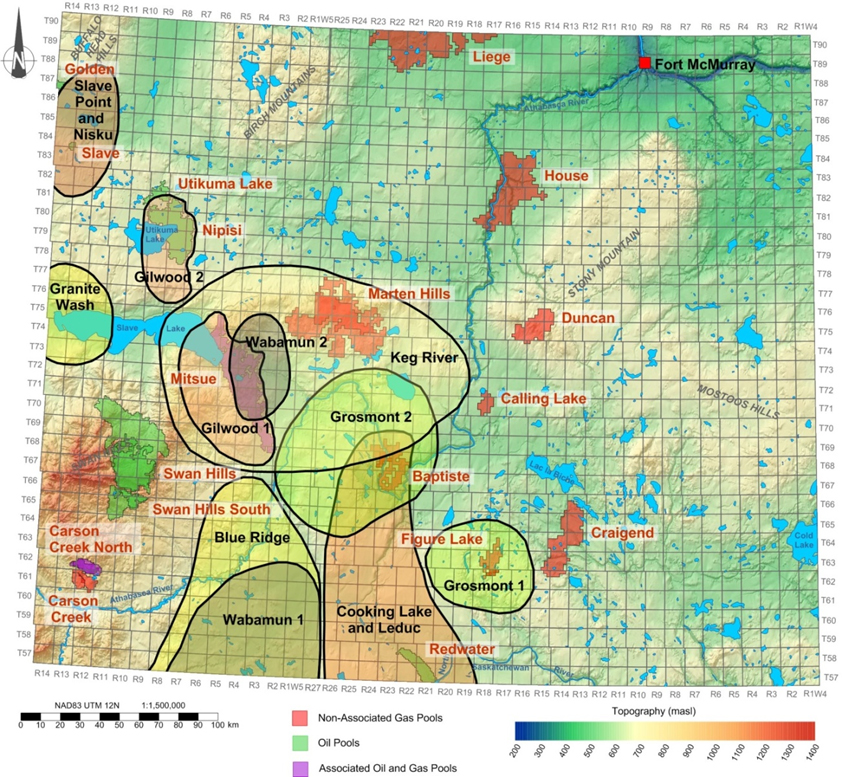Identification of Options for CO2 Storage in the Athabasca Area, Alberta
Lead Proponent: Alberta Innovates – Technology Futures
Location: Alberta
ecoEII Contribution: $ 550,000
Project Total: $ 900,000
Project Background:
Collectively, oil sands producers in the Athabasca area of Alberta are amongst the largest emitters of carbon dioxide (CO2) in Canada. CO2 capture and storage offers a significant opportunity for oil producers in the Athabasca area to reduce the carbon footprint of their operations, and improve the marketability of their product. Provincial regulations require all CO2 storage operations to store CO2 at greater than 1000 m depth. The oil sands operations in the Athabasca area are located in a shallow region of the Alberta basin which is unsuitable for CO2 storage. However, the real potential for CO2 storage in the area west of these operations had yet to be studied and quantified.
To that end, the project “Identification of Options for CO2 Storage in the Athabasca Area” was proposed by Alberta Innovates – Technology Futures to determine the storage capacity and identify potential CO2 storage sites in oil and gas reservoirs and deep saline aquifers in the Devonian sedimentary succession, within the 126,000km2 region west of the Athabasca oil sands. EcoEII awarded $550,000 to the project.
Results:
| Geological Medium | Depth | |||
|---|---|---|---|---|
| > 1 000 m | < 1 000 m | |||
| Oil and Gas Reservoirs | Oil Reservoirs | 7 with Capacity > 5 Mt |
~79 | - |
| All 790 | 215 | - | ||
| Oil Reservoirs with a Gas Cap | 2 with Capacity > 5 Mt |
~14 | - | |
| All 4 | 16 | - | ||
| Gas Reservoirs | 10 with Capacity > 5 Mt |
~141 | 206 | |
| All 423 | 151 | 315 | ||
| CO2 Enhanced Oil Recovery with 12% Oil Recovery Factor and 5 Mscf CO2/STB Net Utilization Factor | 12 Reservoirs with ROIP > 10 × 106 m3 |
155 | - | |
| All 705 | 183 | - | ||
| 13 Deep Saline Aquifers | Entire Aquifer | 19,512 | 8,166 | |
| Dense CO2 Phase Only | 19,196 | 3,805 | ||
| Prospective Areas | 3,769 | 411 | ||
There are 790 oil reservoirs, 4 oil reservoirs with a gas cap and 423 gas reservoirs in the Devonian strata in the study area. 790 oil and 17 gas reservoirs are located at depths greater than 1000m. The capacity for CO2 storage in oil and gas reservoirs in any particular region, at any scale, is given by the sum of the capacities of all reservoirs in that area, calculated using reservoir properties such as original oil or gas in place, recovery factor, temperature, pressure, rock volume and porosity, as well as in situ CO2 density. Nine oil reservoirs and 10 gas reservoirs have individual CO2 storage capacities greater than 5 Mt CO2.
Enhanced oil recovery (EOR) refers to the introduction of heat, chemicals, and/or gases (such as CO2) to stimulate and increase the amount of crude oil that can be extracted from an oil field. 705 oil reservoirs in the study area were identified as being suitable for CO2-EOR. However, the remaining oil in place (ROIP) in most of the reservoirs will be generally too small to warrant the development of CO2-EOR schemes. Only 12 oil reservoirs have ROIP greater than 10 × 106 m3 and of those, half are among the 9 oil reservoirs identified as having greater than 5 Mt CO2 storage capacity. Using CO2 for enhanced oil recovery would be an ideal means for storing CO2 from oil sands production and incremental oil recovery, specifically for the 6 reservoirs with greater than 5 Mt CO2 capacity and greater than 10 × 106 m3 ROIP.

Location of the 19 oil and gas reservoirs and of the 11 prospective saline aquifer areas identified for CO2 storage in the Devonian strata, within the study area
Estimating CO2 storage capacity in an aquifer is difficult because CO2 is buoyant, much less viscous than aquifer water, and because the injected CO2 will neither displace the water in the aquifer, nor reach the entire aquifer pore space. A multi-step approach was taken to determine the CO2 storage capacity in 13 saline aquifers in the Devonian sedimentary succession, and prospective areas for storage were identified in the study area. Techniques such as geological and hydro stratigraphic mapping, assessment of formation water salinity, pressure and temperature, and determination of porosity, permeability, and CO2 phase and density were used to estimate the CO2 capacity (see Table 1 and Figure 1).
Benefits to Canada:
The CO2 storage capacity in the oil sands area of Alberta is many times larger than total greenhouse gas emissions from oil sands operations today. The potential for CO2 capture and storage to contribute to reducing greenhouse emissions exists. Pursuing CO2 storage possibilities will demonstrate to the public the commitment of the sector to reducing its carbon footprint.
Next Steps:
Knowledge generated by this project helps the oil sands industry reduce risks associated with site selection, construction and operation of CO2 storage facilities in the Athabasca area of Alberta.
Page details
- Date modified: